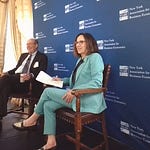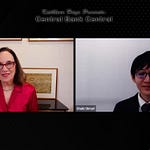As the debate continues over how fast and how far the Fed can cut its key rate this year, the focus continues to be mainly on whether or not inflation will come down quickly enough and if the labor market will soften enough to justify making this long awaited move.
So it was refreshing to switch gears when I spoke with David Andolfatto, who is Chairman of the University of Miami’s business school. I first met him when he was a senior research economist at the Federal Reserve Bank of St. Louis and a senior advisor to former St. Louis Fed President Jim Bullard. We spoke right after the Fed release the minutes of its June meeting, the one where it cut its median forecast for rate cuts this year to one from the three cuts it forecast in December and March.
Dave’s concern is not so much about the economic forces driving inflation, which is what the Fed monitors and responds via its monetary policy decisions, like cutting or raising rates. He thinks it’s entirely possible the Fed may be able to do the one interest rate cut its median Dot forecasts for 2024.
His concern is the government’s fiscal policy path - the large and rising U.S. fiscal deficit which the Fed has no control over but with which it must reckon as the nation’s budget shortfall keeps growing. He says the Fed’s Summary of Economic Projections is too optimistic about how quickly inflation can come down - and importantly STAY down - against this fiscal backdrop.
”I hope I’m wrong,” he says. “In the long run they have the federal funds rate coming down below 3%… they have basically full employment, the economy growing at 2%…I’m not sure how to reconcile those long-run projections with the fiscal situation, at least as portrayed by the CBO (Congressional Budget Office)…projecting a deficit of close to $2 trillion for 2024 and growing deficits going forward.
”So I’m a little bit curious to know how to reconcile low interest rates, low inflation, full employment, with an ever growing deficit,” he adds.
This goes far beyond how soon and how much the Fed can cut rates. Dave’s $64 million dollar fiscal-policy-impact question (which given how much inflation has risen should probably be more like $164 million) centers on whether or not there will be enough global demand to absorb all the U.S. Treasury bonds the government will have to keep issuing.
”Given the risk of growing deficits as projected by the CBO this increased pace of treasury issuance is obviously going to have to be absorbed at some manner in the private sector and the global economy,” he says. “And the question is, is whether the current structure of interest rates or even the lower ones that the Fed is projecting, lower inflation, lower interest rates, is going to be consistent with the global economy absorbing this massive flow of treasury issuance?”
Dave sees a risk that foreign demand for U.S. bonds, which he sees already slowly, will lead to rising Treasury yields, lower Treasury prices to attract buyer. This in turn would boost mortgage rates, corporate borrowing rates and potentially be a big drag o on the economy. Would this lead to more QE, he asks, more bond purchases to boost the economy? If it were to do this the Fed “will be monetizing ever larger larger portions of the government’s growing debt.
”That’s going to be inflationary,” Dave says. “So the Fed is going to be caught between ‘Gosh, should I let interest rates rise or should I try to monetize some of this stuff and cap the interest rates?”
So dive in, take a look and a listen. Let me know what you think.
P.S. Here’s more on who he is, what he is done.
Here’s his bio from the University of Miami’s business school:
David Andolfatto received his Ph.D. in economics in 1994 from the University of Western Ontario, London, Canada. A native of Vancouver, British Columbia, he began his academic career in Canada as a professor of economics. In 2009, he was awarded the Bank of Canada Fellowship Award for his contributions in the theory of money, banking, and monetary policy.
In that same year, David left Canada to become Vice President, and then Senior Vice President, in the research division of the Federal Reserve Bank of St. Louis, where he served as a senior policy advisor for James Bullard, CEO and president of the Bank.
He left the Fed in 2022 to become Chair of the Economics Department at the University of Miami Patti and Allan Herbert Business School.













Share this post